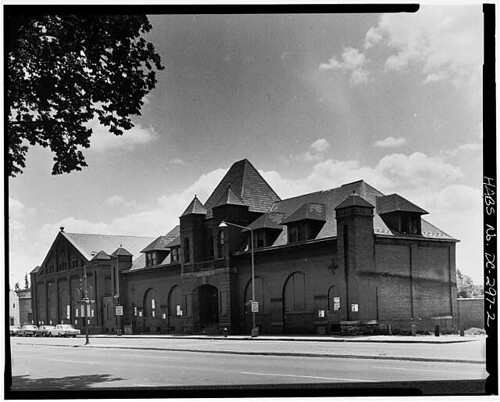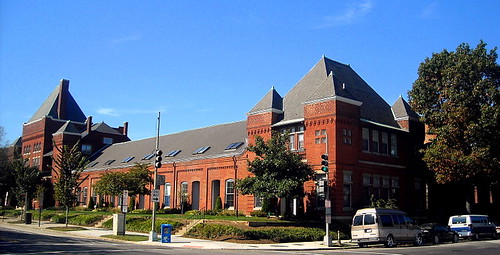Not butt ugly costs a little more: DC streetcar barn edition (transit infrastructure as civic architecture)
WAMU Radio reports, in "Historic Designation More Than Doubles Cost Of D.C. Streetcar Car Barn," that the streetcar barn for the "soon" to open streetcar on H Street NE in DC will cost double the original value-engineered proposal--from $10.7 million to $25.3 million.. There isn't much reportage on issues concerning the architectural quality of the built environment.
Rendering, New Benning Road Streetcar Barn, Washington, DC.

Transit infrastructure as civic architecture
Although it is focused on transit stations as focal points that are intersections between transit systems and infrastructure and neighborhoods, the recent blog entry, "Transit, stations, and placemaking" discusses transit infrastructure as a fundamental element of of civic architecture and the built environment.
While it's clear that a transit agency's primary function is to move people--it's a conveyance--at the same time we must acknowledge the civic role in this function and ensure that we leverage transit stations and stops and other infrastructure, like streetcar barns, not just as connection points where riders enter and exit transit vehicles, but as civic places too, even if that element of transit infrastructure often has been ignored.
I don't think the new streetcar building will be particularly great, but it is marginally better than what was originally intended.
Benning Road Streetcar Barn, torn down in the 1970s. HABS photo.

Interestingly, civic buildings as a positive contribution to the public realm and the built environment was never a question when the city's streetcar barns were built in the late 19th and early 20th century (although then the buildings were constructed and owned by the transit system, which was then privately owned).
(Also see writings about the "City Beautiful" movement, and the role of civic architecture in defining the relationship between citizens and government.)
At that time, the expectation was that buildings such as these would be quality contributions to the built environment, regardless of their industrial nature.
That's obvious by looking at 5 streetcar barns still extant in the city.
In any event, an increase in cost of $15 million, amortized over the 40 to 80 year life of the building, is minimal.
Georgetown Car Barn on M Street NW.
Part of Georgetown Park Mall was once a trolley barn (when the system was run on cables).
Car Barn Condominiums, East Capitol NE. Wikipedia photo.

The "Blue Castle" at 8th and M Streets SE. DC MUD photo.

Decatur Street Bus Garage (on Upper 14th Street NW), constructed in 1906. Wikipedia photo.
Labels: architecture, civic assets, historic preservation, public realm framework, transit infrastructure, urban design/placemaking






10 Comments:
Thought you might enjoy.
http://www.theguardian.com/artanddesign/2013/dec/15/streets-mandela-snapshot-cultural-change-britain
I agree wholeheartedly re: dignified civic buildings. All of the old streetcar barns are wonderful buildings. It is sad that we have all too often built public buildings on the cheap since WWII. My favorite example of a great public building from an earlier age is the O Street Sewage Pumping Station near the ballpark. It was built to pump sewage and it is a wonderful building with nice ornamentation and huge windows. Take a look at it and then take a look at the Reeves Building.
Sigh...
Will have to check out that building. I know of a similar kind of waterworks building in Pittsburgh, on the bus route to Shadyside I think, that is simple and attractive. (Actually there is a similar c. 1890s pumping station on the way to Community Forklift too.)
Matter of fact simplicity, wholeness, and attractiveness.
Charlie--1. great catch thanks. 2. it's like the Chris Rock joke about streets named Martin Luther King Ave. but an important point nonetheless. (I just bought a book called Memorial Mania... haven't gotten it yet.)
I of course reacted with incredulity with attempts to rename a park on 14th St. after Obama was elected, plus all the places that named stuff after Pres. Obama right after election (+ the Nobel Peace Prize...).
Talk about buyer remorse (in terms of actions)...
I agree with the general principle, but don't like the $25 million version any more than I liked the $10 million version. They're both barely good enough, and if that's what we're going to get then I'd rather spend half as much.
Yes, Dan, they suck. Another illustration of the failure to understand the city's core competencies, one being architectural distinctiveness.
You'd be shocked to know I just wrote a piece on Bilbao that justifies their use of distinctive modern architecture as a kind of sculptural or public art element that can be integrated into the traditional built environment because of the critical mass of heritage architecture...
Who knows what would have been possible at Spingarn had they not retained the equivalent of the architects of a Butler building...
http://www.butlermfg.com/
It's kind of damned if you, damned if you don't - at least in regard to antis. To them, even a dollar spent is too much, because they oppose the project no matter what.
Of course an extra $15 million (non recurring) in a 10 billion plus DC city budget is nothing to lose sleep over (especially when it will significantly boost recurring tax revenues).
I just did an article on Bilbao for the EU series of articles I'm doing--I'll put a link up once they post it.
Anyway, what they have done in terms of planning-enabled revitalization is incredible.
And the same goes for transit, which I will write about.
After the Guggenheim Museum opened, they figured it'd be better to have light rail (tram) to connect a couple of Metro stations and provide better connections to the Museum (they have since extended that line, and are building others, in addition to the Metro). They did the first section, albeit not that line, in 4 years from conception to opening. DC will have taken about 12 years to get the streetcar on H St. going...
jdland has a pretty good photo of the O Street sewage pumping station:
http://www.jdland.com/dc/wasa.cfm
Note the ugly modern addition addition...
Amazing content and site structure.
Online Business Ideas
Post a Comment
<< Home